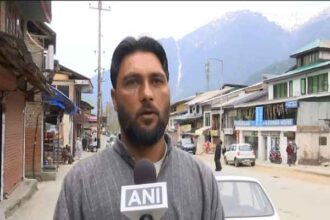The horrific terror attack in Pahalgam on April 22, 2025, claimed 26 innocent lives. It was a calculated attempt by Pakistan-backed terrorists to sabotage Kashmir’s peace and economic progress. Security and intelligence sources reveal the attackers were driven by Islamabad’s frustration over the valley’s growing stability. The region’s tourism boom and strengthening bond between communities also contributed to the attack. The attackers included Pakistani nationals aided by local collaborators.
Pakistan’s Inability to Digest Kashmir’s Peace Dividend
Since 2019, Jammu and Kashmir has witnessed unprecedented development and normalization after Article 370 was abrogated. The valley’s economy has grown at 7.8%, slightly outpacing the national average. Tourism revival has fueled this growth, creating thousands of jobs and improving livelihoods. Education and infrastructure have expanded significantly. Social harmony between Hindu and Muslim communities has strengthened. Kashmiris are increasingly integrated into India’s broader socio-economic fabric.
This transformation has dealt a severe blow to Pakistan’s long-standing proxy war strategy. The strategy relied heavily on terror recruitment and fomenting unrest. Indian security agencies report a sharp decline in local militant recruitment. Many former hotbeds of terrorism, like Pulwama, have seen no new local recruits in recent years. Growing economic opportunities and a peaceful environment have made the valley inhospitable to terror groups. This has frustrated Pakistan’s attempts to destabilize the region.
Terror Attack Aimed at Breaking Communal Harmony and Economic Growth
The Pahalgam attack was deliberately designed to target Hindu tourists. This move violates an unwritten ‘Code’ previously observed by terrorist outfits. The terrorists sought to inflame communal tensions and provoke a backlash. Intelligence sources indicate Pakistan’s military establishment sanctioned the attack. The goal was to revive terrorism and reassert Pakistan’s stake in Kashmir.
The attack’s timing and brutality aimed to undermine Kashmir’s tourism industry. Tourism is a critical driver of economic prosperity in the valley. The attack led to massive cancellations of tourist bookings and fear among visitors. This threatens the livelihoods of thousands of families dependent on tourism. The economic disruption aligns with Pakistan’s strategy to stall Kashmir’s development. Pakistan aims to maintain Kashmir as a conflict zone.
Pakistan’s Proxy War and the ‘Munir Doctrine’
The attack reflects a hardened military doctrine from Pakistan’s GHQ in Rawalpindi, known informally as the ‘Munir Doctrine.’ It seeks to sabotage Kashmir’s peace by escalating violence and reviving terror recruitment. This doctrine emerged amid Pakistan’s internal challenges, including economic downturns and rising insurgency within its own borders. It is this that is compelling the military to double down on Kashmir as a unifying cause.
Pakistan’s frustration is compounded by its diplomatic isolation and the diminishing traction of the Kashmir issue on international platforms. By orchestrating high-profile terror attacks, Pakistan aims to draw global attention back to Kashmir. It also portrays the conflict as a popular uprising, despite the reality of declining local terrorist participation.
A Calculated Attempt to Destabilize Mainland India
Beyond Kashmir, the attack fits into a broader strategy to disrupt communal harmony across India. Terrorists targeted Hindu tourists in a Muslim-majority region to inflame religious divisions. This aimed to provoke a heavy-handed security response, alienating local populations. The cycle of violence and retaliation seeks to foster instability in Kashmir and the wider Indian mainland.
Local Support and Sophisticated Planning
Investigations reveal that the terrorists received significant local support from overground workers who facilitated their infiltration, logistics and arms supply. The attackers conducted extensive reconnaissance of the Baisaran meadows, exploiting the terrain’s remoteness and security gaps. They did this to maximize casualties and escape chances. The use of sophisticated weaponry, including AK-47s and US-made M4 carbines, underscores the high level of training and external backing.
Kashmir Rejects Terrorism
Despite the terror strike, the people of Kashmir have overwhelmingly condemned the attack. They’ve united across religious and social lines to denounce violence. The entire valley observed a shutdown and held protests demanding justice and peace. Locals have extended a warm invitation to tourists, vowing to protect them. They aim to preserve Kashmir’s reputation as a peaceful and welcoming destination.
Reigniting the Terrorism
The Pahalgam terror attack starkly exposes Pakistan’s inability to accept peace, prosperity and communal harmony in Kashmir. Frustrated by the valley’s economic growth and social integration, Pakistan’s military establishment has resorted to violence. Their aim is to derail progress and reignite conflict. However, the resilience of Kashmir’s people and strengthening bonds between communities stand as barriers against such tactics. The path ahead requires continued vigilance, robust security and unwavering support for Kashmir’s development and peace.
It’s worth noting that the attack has sparked a mix of emotions. The people of Kashmir wholeheartedly condemned the violence and showed solidarity with the victims. Meanwhile, Pakistan’s social media space has been used to spread misinformation and propaganda. Several users mocked the victims and blamed India for the attack. India’s response to the attack has included informing Pakistan of its decision to keep the Indus Waters Treaty in abeyance. Despite rising tensions, Kashmir remains calm, reflecting the region’s exhaustion and resilience.







